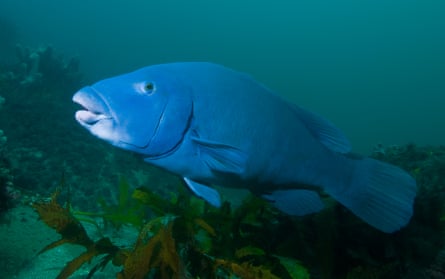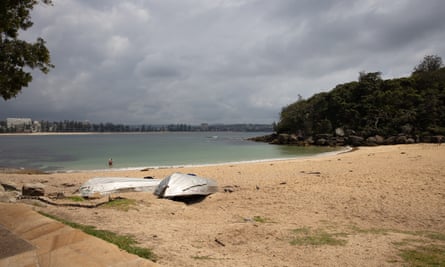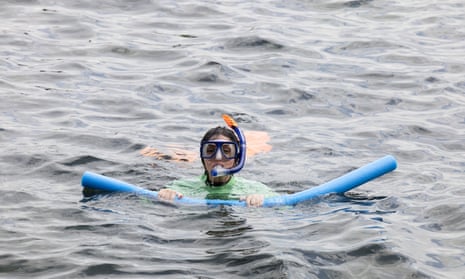As clouds roll overhead, a salty mist lies low over the timid waves of Manly’s Shelly Beach. Despite grey skies, the protected stretch of sand in Sydney’s northern beaches thrums with locals.
“This area is an aquatic reserve,” Damien McClellan, founder of tourism company EcoTreasures, tells our tour group. “If you look behind you, you’ll see sandstone cliffs.”
McClellan points across the water to jutting, weathered rock faces, with layered, tan ridges. “Sydney’s sandstone coast is beautiful,” he says. I nod along with the tour group in agreement.
We are standing at the headland, looking over bays and beaches lining the coast of Sydney’s north. Cabbage Tree Bay is closest. Sheltered by its reef and rocky geography, the bay does not get pummelled by surf, making it perfect for a snorkel or dive.
It is where our tour group is heading for a guided lesson in the former. First, we struggle into wetsuits. Then we learn how to enter the water.

“You’re going to look over your shoulder and walk backwards down the ramp,” McClellan tells us. “Then dunk yourself under.”
It is my first time snorkelling. The water has been made murky by recent rains, and I’m nervous about lots of things, including (but not limited to) the possibility of mysterious creatures lurking deep, out of sight.
We are fitted with flippers, goggles, and wetsuits. We are also given pool noodles to help keep ourselves afloat, so our flippers don’t disrupt any life on the sea floor.

McClellan says, when fitting snorkelling goggles to your face, to press down until you feel a “suction” around the eyes. He also says to position the strap on the crown of your head, to ensure the goggles are secure enough for no saltwater to get in.
But before fitting the goggles to your face, McClellan suggests rubbing a bit of baby shampoo to the lenses and then rinsing with water. This helps prevent your goggles fogging up while you swim.
McClellan asks me: “Have you ever looked under the water before? How long did you look for? What did you see?”
My answers: Yes (eyes closed, without goggles). Not for long. Not much.
“Well, that’s just it,” he laughs. McClellan tells me that “too often”, people forget to pause, breathe, and simply “look” when in the water.

“With snorkelling, you never know what you’re going to see,” he says. “And part of it is relaxing.”
He explains that many people snorkel “for the disconnection”. As you focus on your breathing while underwater, you slow down. “When you do that, you see the most amazing stuff.”
He is right. With your head and body submerged, all sounds are muted. We float across a sea meadow of thick, flowing kelp and algae which lines the left of the reserve.
Translucent blobs called jimble float by. Earlier, a stranger in the change rooms told me to “not worry about those,” because “they won’t sting you”.
Big, friendly groupers swim up to our faces and schools of small fish jet past, getting lost in the seagrass.
Even on low visibility days like this, if you stay still and let yourself sway with the water long enough, you catch glimpses of purple rock beneath the kelp, unmoving on the seafloor.
Once I’m accustomed to the water, my goggles and flippers feel less awkward, breathing through a snorkel becomes less laboured, and swimming comes with ease.

McClellan recalls a German tourist once describing the experience as being among “the lungs of the ocean”.
A perfect description, I think.
After the guided tour, we return our gear to McClellan. I ask him about future snorkelling lessons, which cost $79 per adult on group tours. It is something I want to come back and do again, next time with my family.
He says snorkelling is “easy entry”.
“People get nervous about aquatic activities. But getting nervous is a great human feeling. And snorkelling is a good start at doing something adventurous.
“It’s one of those cool activities that generations of family can do together … A lot of adventure activities are strenuous. But kids, parents, grandkids, grandparents can all snorkel.”
Plus, it doesn’t take much to start. McClellan says purchasing a “good mask” will cost $80 or less. A wetsuit ranges from $100 to $200; though not essential, it will protect your body from the temperatures of the ocean, allowing you to stay in the water for longer. It will also “last you a decade”, McClellan says.
“And the water is free.”

The Cabbage Tree Bay aquatic reserve is McClellan’s top snorkelling spot in Sydney. He says conservation efforts made it so.
“It has been a no fishing zone since 2002.”
Since then, the area has flourished. The aquatic reserve is home to more than 150 species of fish, including protected and threatened species like weedy seadragons and elegant wrasse.
Other aquatic reserves – like Clovelly and Fisherman’s Beach at Long Reef in Sydney – are great spots for beginner snorkellers. Outside of the harbour city, would-be snorkellers should look for spots with calm waters, and ideally some kind of conservation status – protection of marine biodiversity means there is lots to see.
“This is an awesome example of good conservation management, and we can do better,” McClellan says of Cabbage Tree Bay. “Natural space like this – it is priceless.”
This piece was supported by Destination NSW and EcoTreasures

Comments (…)
Sign in or create your Guardian account to join the discussion